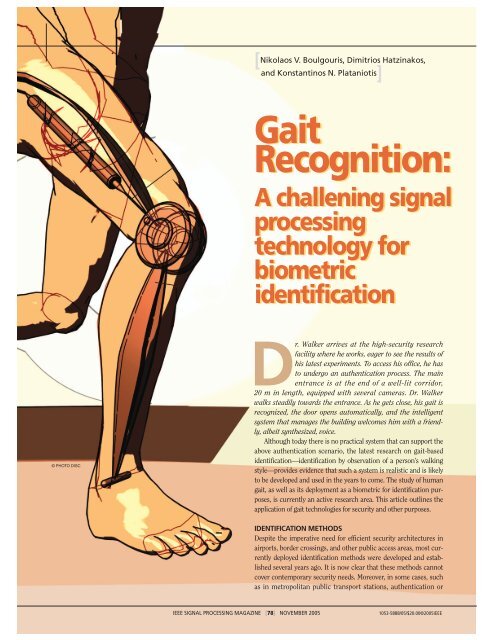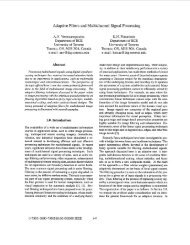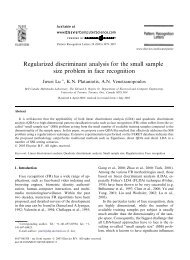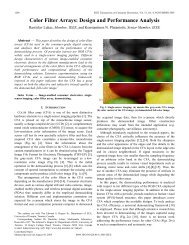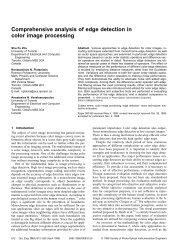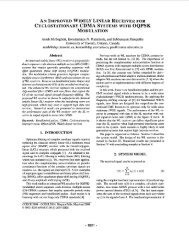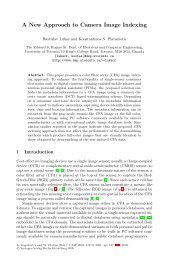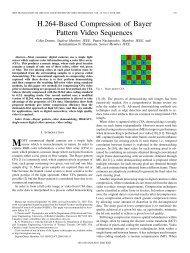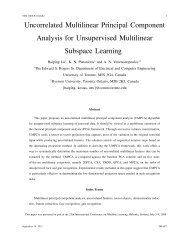Gait Recognition: Gait Recognition: - ABES Engineering College
Gait Recognition: Gait Recognition: - ABES Engineering College
Gait Recognition: Gait Recognition: - ABES Engineering College
Create successful ePaper yourself
Turn your PDF publications into a flip-book with our unique Google optimized e-Paper software.
into account the gait dynamics. All methods in this class yieldstate-of-the-art performance.GAIT ANALYSIS FOR FEATURE EXTRACTIONFor the study of gait analysis, we assume that the walking subjecthas been extracted from a gait sequence using standardimage processing techniques. Henceforth, we focus on featureextraction from background-subtracted sequences. Below, wedivide gait analysis techniques into model based and holistic.Furthermore, we summarize the approaches for the reductionof the dimensionality of the original feature vectors.GAIT CYCLE DETECTIONAn important part of the gait analysis process is gait cycle detection,i.e., the partitioning of a gait sequence into cycles thatdepict a complete walking period. In almost all approaches seenthus far in the literature, the detection of gait cycles is achievedusing a time series corresponding to a measure extracted from asequence (e.g., the sum of foreground pixels of silhouettes). Thissignal is usually very noisy and requires processing before itsanalysis. In [21], although no explicit cycle partitioning wasattempted, a method using linear prediction was proposed forfitting a sinusoidal signal to the noisy extracted signals. Thismethod could be readily used for cycle partitioning. In [32], anadaptive filter was used to filter the foreground sum signal priorto the calculation of the gait cycles using the minima of this signal.In [38], the autocorrelation of the foreground sum signalwas taken to calculate the walking period and compute the coefficientsof an optimal filter for the denoising of the sum signal.Figure 3(a) shows the foreground sum signal sum(t) withrespect to time, and Figure 3(b) represents the correlationbetween signal samples sum(t 1 ), sum(t 2 ) with respect to thetime difference |t 1 − t 2 |. By observing the autocorrelation peaksin Figure 3(b), it is easy to determine the walking period andpartition the signal in Figure 3(a) into gait cycles. In general,there are several efficient methodologies for partitioning gaitsequences into gait cycles; henceforth, we assume that such apartitioning is available to the gait recognition system.MODEL-BASED APPROACHESModel-based approaches employ models whose parameters aredetermined using processing of gait sequences [30], [39], [40],[41]. Unlike holistic approaches, model-based approaches are, ingeneral, view and scale invariant. This is a significant advantageover the holistic approaches since it is highly unlikely that a testgait sequence and a reference sequence will be captured from identicalviewpoints. However, since model-based approaches rely onthe identification of specific gait parameters in the gait sequence,these approaches usually require high-quality gait sequences to beuseful. Moreover, other hindrances such as self-occlusion of walkingsubjects may even render the computation of model parametersimpossible. For this reason, a multicamera gait-acquisitionsystem would be more appropriate for such techniques.A multiview gait recognition method was proposed in [39]using recovered static body parameters, which are measurementstaken from static gait frames. <strong>Gait</strong> dynamics are not used.The static parameters used in [39] are the height, the distancebetween head and pelvis, the maximum distance between pelvisand feet, and the distance between the feet [Figure 4(a)]. Thestatic parameters are view invariant, which makes them veryappropriate for recognition applications.In [30], the silhouette of a walking person was divided intoseven regions. Ellipses were fit to each region [Figure 4(b)] andregion feature vectors were formed, including averages of thecentroid, the aspect ratio, and the orientation of the major axisof the ellipse. Another feature vector that was tested includedthe magnitude and phase of a Fourier transform of the timeseries of the above ellipse parameters.In [40], a model-based feature analysis method was presentedfor the automatic extraction and description of human gaitfor recognition. The method generated a gait signature using aFourier series expansion of a signal corresponding to the hip5004003002001000−100−200−300−400−5000 20 40 60 80 100 120 140 160 180(a)10.90.80.70.60.50.40.30.20.100 5 10 15 20 25 30 35 40(b)[FIG3] (a) Foreground sum signal (normalized). (b) Autocorrelation.IEEE SIGNAL PROCESSING MAGAZINE [82] NOVEMBER 2005
N−1 ∑p h [i ] = s[i, j], i = 0,...,M − 1 (1)j=0M−1 ∑p v [ j] = s[i, j], j = 0,...,N − 1. (2)i=0The efficiency of this feature is based on the fact that it is sensitiveto silhouette deformations since all pixel movements arereflected in the horizontal or vertical projection [Figure 5(b)].Although this feature is similar to the width of silhouette (notethe similarity between the width vector and the horizontal projectionvector), it is more robust to spurious pixels. An additionaladvantage is that it is fast and can be computed in real time.However, an important consideration here is that the silhouettesmust be centered prior to the computation of the feature sincemisplaced silhouettes will result in shifted projections.An angular transform of the silhouette was proposed in [28].The angular transform divides the silhouettes into angular sectorsand computes the average distance between foregroundpixels and the center (i c , j c ) of the silhouette [Figure 5(c)]A(θ) = 1 ∑ √s[i, j] (i − i c )N 2 + ( j− j c ) 2 , (3)θ (i, j)∈F θwhere θ is an angle, F θ is the set of the pixels in the circularsector [θ − (θ/2), θ + (θ/2)], and N θ is the cardinality ofF θ . The transform coefficients were shown to be a linear functionof the silhouette contour. This feature is, in general, robustsince it obviates the need for detection of contour pixels. Thebottom of Figure 5(c) displays the transform coefficients withrespect to time. As seen, most information is concentrated inthe leg area (appearing on the plot as rings).The silhouette itself was used in several algorithms as a feature.Prior to their deployment, the silhouettes in a gaitsequence should be appropriately scaled and aligned. In mostcases, it appears that the silhouette is at least as efficient as thelow-dimensional features that can be extracted from a silhouette.This is intuitively expected since the feature extraction stepis a lossy operation, i.e., in general, the silhouette cannot bereconstructed from the feature. However, the silhouette featureleads to systems of high complexity, whereas feature extractioncould dramatically reduce complexity. Since there is someinformation in a silhouette that is apparently useless for recognition(e.g., the interior of the body), we believe that there areefficient features that will perform at least as well as the silhouettefeature. In our pursuit for the ideal feature, the silhouettefeature provides a useful target for gait performance.The advantages and disadvantages of all presented featuresare summarized in Table 2.FREQUENCY TRANSFORMATIONOF FEATURE TIME SERIESRegardless of the way in which a vector of features f(t) is extractedfrom each frame (i.e., for each t) of a gait sequence, we canalways go a step further. All features extracted thus far from eachof the frames in a gait sequence form a time series. Since walkingis a periodic activity, the Fourier analysis of the time-domain gaitsignals is a very appealing approach as most discriminative informationis expected to be compacted in a few Fourier coefficients,providing a very efficient gait representation. Therefore, takingthe Fourier transform of the feature vector series f(t)F(k) = 1 ∑T−1f(t)e − j2π T kt , (4)Tt=0where T is the walking period, yields a new representation thatis related to the frequency content of the originally extractedfeatures. The new representation can serve as a gait signature,which is appropriate for direct comparison between gaitsequences. The frequency-domain extraction of gait signatures[TABLE 2] SUMMARIZATION OF THE ADVANTAGES AND DISADVANTAGESOF THE PRESENTED HOLISTIC AND MODEL-BASED FEATURES.HOLISTIC FEATURESFEATURE ADVANTAGES DISADVANTAGESCONTOUR SENSITIVE TO STRUCTURAL DIFFERENCES HIGH COMPLEXITY, LOW ROBUSTNESSWIDTH SENSITIVE TO STRUCTURAL DIFFERENCES, LOW COMPLEXITY LOW ROBUSTNESSPROJECTIONS ROBUSTNESS, LOW COMPLEXITY COARSE STRUCTURAL REPRESENTATIONANGULAR ROBUSTNESS COARSE STRUCTURAL REPRESENTATIONRELATIVE PHASES COMPACT REPRESENTATION, SCALE INVARIANCE COMPLICATED DETERMINATION OFPHASESSILHOUETTE LOSSLESS REPRESENTATION LEADS TO HIGH-COMPLEXITY SYSTEMSMODEL-BASED FEATURESFEATURE ADVANTAGES DISADVANTAGESSTATIC PARAMETERS VIEW INVARIANT, COMPACT REPRESENTATION DIFFICULT CAPTURING (REQUIRESCAMERA CALIBRATION)ELLIPSE PARAMETERS COMPACT REPRESENTATION LOW ROBUSTNESSHIP ANGLE COMPACT REPRESENTATION LOW ROBUSTNESSCOMBINATION OF SHAPE COMPACT REPRESENTATION LOW ROBUSTNESSPARAMETERSIEEE SIGNAL PROCESSING MAGAZINE [84] NOVEMBER 2005
has advantages over the time-domain approach. Specifically,since the transform is calculated in increments of the angularfrequency 2π/T, signals extracted from gait sequences withdifferent walking periods are directly comparable. In practice,however, not all frequency components are useful for recognition.This is why there are methods that use only the magnitudeand phase of the Fourier transform at the fundamentalwalking frequency [30], [44].In [44], it was stated that all motions in a gait cycle sharethe same fundamental frequency, and a system was proposedwhich uses optical flow for measuring shape oscillations. Asignificant conclusion reached in [30] was that frequency signaturesyielded superior performance in cases where the comparedgait sequences were captured on different days (and,therefore, the structural information alone was not reliable).This provides an additional motive for investigating frequency-domainfeatures.In the experimental assessment section, we will evaluate theperformance of a simple scheme based on the direct transformationof features. In this system, the entire feature time series isexpressed as a single complex feature vector through application of(4). In Figure 6, we display such a representation using silhouettes.DIMENSIONALITY REDUCTIONA natural question arises in the context of gait analysis: Howmuch information do we need to extract from a gait sequence inorder to capture most discriminative information?On the temporal axis, it appears that shape information can becaptured using four or five characteristic frames [14], [32] or featurevectors. However, the frames or feature vectors themselvescould be represented in a more compact way. Since several of theelements in the feature vectors, extracted using the techniques inthe previous sections, usually contain information that does notcontribute to the purpose of recognition, methodologies such asprincipal component analysis (PCA) [43], [24], [27] or linear discriminantanalysis (LDA) [24] are used to retain only the importantelements of the original feature vector. Analysis of variance(ANOVA) can also be used for the identification of the significantcomponents in a gait feature vector. Several works achieve goodperformance using holistic features of dimension as low as 100.On the other hand, feature vectors consisting of model parameterswould carry more information than feature vectors extractedusing a holistic method. This is the reason why, for model-basedapproaches, the required coefficients might be fewer provided thatthe model parameters can be determined accurately (which is thereal challenge in model-based approaches).PATTERN MATCHING AND CLASSIFICATIONOnce gait information is extracted from gait sequences and theassociated feature vectors are formed, the actualrecognition/classification task must be performed. Two mainapproaches can be taken, namely, a template-based approach ora stochastic approach. In both cases, an appropriate distancemetric between feature vectors must be initially defined. Theclassical Euclidean distance is the measure that is used in mostgait recognition applications. Other measures are the innerproduct distance [32] and the number of “ones” in the binarydifference between frames [23]. A variety of other distance measuresmay also be used [45]; however, in this work, we use theclassical Euclidean distance in the implementations of the presentedgait methodologies.TEMPLATE MATCHINGThe main concern in calculating distances between different gaitrepresentations (templates) is whether we compare correspondingquantities in the two representations. In case of frequencytemplates (e.g., harmonic components computed using Fourieranalysis), the calculation of the distance between two templatesis straightforward since the correspondence between frequencycomponents in different templates is obvious. In this case, a frequencycomponent in one template should be compared with thecomponent in the same spectral position in the other template.In the case of spatial templates, the gait representation is asequence of features that must be compared with anothersequence of features. When the fundamental walking periods T 1and T 2 of the two sequences are not equal, their cumulative distanceover a gait cycle is defined asD 12 = 1 T∑u(t)D(f 1 (w 1 (t)), f 2 (w 2 (t))),Ut=1where the pairs (w 1 (t), w 2 (t)) define a warping function, u(t) is aweighting function, U = ∑ Tt=1 u(t), and D(·) denotes the distancebetween the feature vectors at time t. Based on the characteristicsof the warping function, we can distinguish three approaches forthe calculation of distances between feature sequences.The direct matching approach can be regarded as a brute-forceattempt to match a pattern consisting of feature vectors (derivedfrom frames in a gait cycle) by sliding it over a sequence of feature(a)(b)[FIG6] Frequency signatures: a complex silhouette templatecomputed as the Fourier transform of the gait sequence at thefundamental frequency. (a) Real part and (b) imaginary part.IEEE SIGNAL PROCESSING MAGAZINE [85] NOVEMBER 2005
T 2Having computed the distances between a test subject andall subjects in a reference database, the recognition decision istaken asidentity(i ) = arg min D ij , jwhere D ij denotes the cumulative distance between the i thtest subject and the jth reference subject. This means that theidentity of the test subject is assumed to be the identity of thereference subject with which the test subject has the minimumdistance.T 2T 1(a)T 2T 1(b)T 1vectors of the reference sequence to find the position that yieldsthe minimum distance. This is the approach taken in the baselinemethod created at USF [23]. However, this approach is clearly notsuitable for a gait recognition system since it implicitly assumesthat the periods of the gait cycles in the test and referencesequences are identical. Therefore, two sequences depicting thesame person walking at different speeds would appear dissimilar.The use of time normalization [46] is a more reasonableapproach since reference and test sequences corresponding tothe same subject may not necessarily have the same gait period.Consequently, if recognition is to be performed by templatematching, some kind of compensation would have to be appliedduring the calculation of the distance. To this end, dynamictime warping (DTW) [46] can be used to calculate the distancebetween a test sequence and a reference sequence. Using DTW[43], [38], all distances between test and reference frames arecomputed and the total distance is defined as the accumulateddistance along the minimum-distance path (termed the optimalwarping path). Another option is to use linear time normalization.Experiments demonstrate that linear time normalizationrivals the performance of DTW. This conclusion is in contrast toour intuitive expectation based on speech recognition paradigms,in which DTW was reported to be much more efficientthan linear time normalization [46]. The above approaches fortemplate matching are depicted in Figure 7.(c)[FIG7] Approaches for the matching of different sequences.(a) Direct, (b) dynamic time warping, and (c) linear time normalization.STATISTICAL APPROACH: HMMSUsing the template matching approaches outlined in the previoussection, the extent of similarity between walking stylesis quantitatively described using distances based on a distancemetric. This is a disadvantage; on one hand, such distancesmay not have a clear interpretation whereas, on theother hand, the pattern of states related to the succession ofstances during walking is not explicitly taken into account.For the above reasons, stochastic approaches such as HMMs[47] can also be used for gait recognition [32], [48]. In practicalHMM-based gait recognition, each walking subject isassumed to traverse a number of stances (see Figure 8). In otherwords, each frame in a gait sequence is considered to be emittedfrom one of a limited number of stances. The a priori probabilities,as well as the transition probabilities, are used to definemodels λ for each subject in a reference database. For a testsequence of feature vectors ˜f i , the probability that it was generatedby one of the models associated with the databasesequences can be calculated by( )P ˜fi /λ j , j = 1,...,N,where N is the number of subjects in the reference database. Thesubject corresponding to the model yielding the higher probabilityis considered to be identical to the test subject, i.e.,identity(i ) = arg maxj( )P ˜fi /λ j , j = 1,...,N.The HMM-based methodology is, in many aspects, preferable toother techniques since it explicitly takes into consideration notonly the similarity between shapes in the test and referencesequences, but also the probabilities with which shapes appear andsucceed each other in a walking cycle of a specific subject.From LastState[FIG8] A left-to-right hidden Markov model for gait recognition.To FirstStateEXPERIMENTAL ASSESSMENTTo evaluate the efficiency of the maingait analysis and recognitionapproaches that were presented previously,we considered several features,as well as both the template matchingand statistical approaches for theIEEE SIGNAL PROCESSING MAGAZINE [86] NOVEMBER 2005
10010090908080Cumulative Match Score70605040302010Probe AProbe BProbe CProbe DProbe EProbe FProbe GCumulative Match Score70605040302010Probe AProbe BProbe CProbe DProbe EProbe FProbe G00 5 10 15 2010090Rank(a)00 5 10 15 2010090Rank(b)8080Cumulative Match Score70605040302010Probe AProbe BProbe CProbe DProbe EProbe FProbe GCumulative Match Score70605040302010Probe AProbe BProbe CProbe DProbe EProbe FProbe G00 5 10 15 20Rank(c)00 5 10 15 20Rank(d)Cumulative Match Score100908070605040302010Probe AProbe BProbe CProbe DProbe EProbe FProbe G00 5 10 15 20Rank(e)[FIG9] Cumulative match scores for different recognition approaches using the silhouette feature. (a) Frequency signature, (b) dynamictime warping, (c) linear time normalization, (d) structural matching, and (e) hidden Markov models.IEEE SIGNAL PROCESSING MAGAZINE [88] NOVEMBER 2005
For the evaluation of the impact of capturing conditionvariations to the performance of the gait recognition system,we report detailed results on the USF database. As seen inTable 4, the performance of the gait recognition system is satisfactorywhen there are changes in shoe or/and viewpoint.However, in cases of excessive viewpoint differences betweenreference and test sequences, the distortions on the extractedfeature vectors would be considerable and, unavoidably, thiswould have a detrimental effect on recognition performance.Clearly, the performance of most tested algorithms sufferswhen a change in surface is involved. This is an important conclusion,and it imposes some limitations on the capturingprocess appropriate for a gait recognition system, i.e., surfacevariations should be avoided. The complete cumulative matchscores are displayed in Figure 9. As seen, in most cases, thecorrect subject was with high confidence in the top ten matches(out of a total of 71 subjects in the reference database). Thisprovides a strong indication that, even if gait is currently notable to achieve reliable exact recognition, it can be readily usedin a multibiometric system as an efficient filter prior to theutilization of some other biometric.SUMMARY AND CONCLUSIONSThis article was intended to provide an overview of the basicresearch directions in the field of gait analysis and recognition.The recent developments in gait research indicate that gait technologiesstill need to mature and that limited practical applicationsshould be expected in the immediate future. At present,there is a potential for initial deployment of gait for recognitionin conjunction with other biometrics. However, future advancesin gait analysis and recognition—an open, challenging researcharea—are expected to result in wide deployment of gait technologiesnot only in surveillance, but in many other applicationsas well. We hope that this article will expose the gait analysisand recognition problem to the signal processing communityand that it will stimulate the involvement of more researchersin gait research in the future.ACKNOWLEDGMENTThis work was partially supported by Bell University Laboratoriesat the University of Toronto and by a Communications andInformation Technology-Ontario (CITO) grant.[TABLE 4] THE IMPACT OF DIFFERENCES IN CAPTURINGCONDITIONS TO THE PERFORMANCE OF GAITRECOGNITION SYSTEMS USING THE USF/NIST(GAIT CHALLENGE) DATABASE. THE AVERAGE OFRESULTS FOR ALL RECOGNITION METHODSUSING THE SILHOUETTE FEATURE IS REPORTED.PROBE DIFFERENCE RANK-1 RANK-5A VIEW 90 98B SHOE 80 87C SHOE, VIEW 68 83D SURFACE 25 53E SURFACE, SHOE 21 57F SURFACE, VIEW 18 51G SURFACE, SHOE, VIEW 18 46AUTHORSNikolaos V. Boulgouris received the Diploma and the Ph.D.degrees in electrical and computer engineering from theUniversity of Thessaloniki, Greece, in 1997 and 2002, respectively.Since December 2004, he has been a lecturer with theDepartment of Electronic <strong>Engineering</strong>, Division of <strong>Engineering</strong>,at King’s <strong>College</strong>, London, United Kingdom. From September2003 to November 2004, he was a postdoctoral Fellow with theDepartment of Electrical and Computer <strong>Engineering</strong>, Universityof Toronto, Canada. Previously, he was affiliated with theInformatics and Telematics Institute in Greece. He has participatedin several research projects in the areas of pattern recognition,image/video communication, multimedia security, andcontent-based indexing and retrieval. He is a Member of theIEEE and the British Machine Vision Association.Dimitrios Hatzinakos received the Diploma degree from theUniversity of Thessaloniki, Greece, in 1983, the M.A.Sc. degreefrom the University of Ottawa, Canada, in 1986, and the Ph.D.from Northeastern University, Boston, Massachusetts, in 1990,all in electrical engineering. In September 1990, he joined theDepartment of Electrical and Computer <strong>Engineering</strong>, Universityof Toronto, where he is a tenured professor. Also, he served aschair of the Communications Group of the department duringthe period from July 1999 to June 2004. Since November 2004,he is the holder of the Bell Canada Chair in Mutimedia at theUniversity of Toronto. His research interests are in the areas ofmultimedia signal processing and communications. He isauthor/coauthor of more than 150 papers in technical journalsand conference proceedings and he has contributed to eightbooks in his areas of interest. He was an associate editor for theIEEE Transactions on Signal Processing from 1998–2002 andguest editor for a special issue of Signal Processing. He was amember of the IEEE Statistical Signal and Array ProcessingTechnical Committee (SSAP) from 1992–1995 and technicalprogram cochair of the Fifth Workshop on Higher-OrderStatistics in July 1997. He is a Senior Member of the IEEE anda member of EURASIP, the Professional Engineers of Ontario(PEO), and the Technical Chamber of Greece.Konstantinos N. (Kostas) Plataniotis received the B.Eng.degree in computer engineering and informatics fromUniversity of Patras, Greece, in 1988 and the M.S. and Ph.D.degrees in electrical engineering from Florida Institute ofTechnology, Melbourne, in 1992 and 1994, respectively. He isan associate professor with the Edward S. Rogers Sr.Department of Electrical and Computer <strong>Engineering</strong> at theUniversity of Toronto in Toronto, Ontario, and an adjunct professorwith the School of Computer Science at RyersonUniversity. His research interests include image and signal processing,communications systems, and pattern recognition. Heis a registered professional engineer in the province of Ontario,and a member of the Technical Chamber of Greece. He is anassociate editor for IEEE Transactions on Neural Networks, theimage processing area editor for the IEEE Signal ProcessingIEEE SIGNAL PROCESSING MAGAZINE [89] NOVEMBER 2005
Society e-letter, the technical program cochair for IEEEInternational Conference on Multimedia & Expo (ICME06), andthe vice-chair for the IEEE Intelligent Transportation SystemsConference (ITSC 2006). He is the 2005 recipient of IEEECanada’s Outstanding <strong>Engineering</strong> Educator Award.REFERENCES[1] A.K. Jain, L. Hong, S. Pankanti, and R. Bolle, “An identity verification systemusing fingerprints,” Proc. IEEE, vol. 85, no. 9, pp. 1365–1388, Sept. 1999.[2] M. Turk and A. Pentland, “Face recognition using eigenfaces,” in Proc. IEEEConf. Computer Vision and Pattern <strong>Recognition</strong>, Maui, HI, June 1991, pp.586–591.[3] A.K. Jain and N. Duta, “Deformable matching of hand shapes for verification,”in Proc. IEEE Conf. Image Processing, Kobe, Japan, Oct. 1999, pp. 857–861.[4] J. Daugman, “High confidence visual recognition of persons by a test of statisticalindependence,” IEEE Trans. Pattern Anal. Machine Intell., vol. 15, no. 11,pp. 1148–1161, 1993.[5] L. Rabiner and B. Juang, Fundamentals of Speech <strong>Recognition</strong>. EnglewoodCliffs, NJ: Prentice-Hall, 1993.[6] Y. Qi and B.R. Hunt, “A multiresolution approach to computer verification ofhandwritten sigantures,” IEEE Transactions Image Processing, vol. 4, no. 6,pp. 870–874, June 1995.[7] L. Sloman, M. Berridge, S. Homatidis, D. Hunter, and T. Duck, “<strong>Gait</strong> patterns ofdepressed patients and normal subjects,” Am. J. Psychiatry, vol. 139, no. 1, pp.94–97, 1982.[8] M.D. Addlesee, A. Jones, F. Livesey, and F. Samaria, “ORL active floor,” IEEEPers. Commun., vol. 4, no. 5, pp. 35–41, Oct. 1997.[9] J. Kittler, M. Hatef, R.P.W. Duin, and J. Matas, “On combining classifiers,” IEEETrans. Pattern Anal. Machine Intell., vol. 20, no. 3, pp. 226–239, Mar. 1998.[10] P.C. Cattin, D. Zlatnik, and R. Borer, “Sensor fusion for a biometric systemusing gait,” in Proc. Int. Conf. Multisensor Fusion and Integration forIntelligent Systems, Baden-Baden, Germany, Aug. 2001, pp. 233–238.[11] G. Shakhnarovich, L. Lee, and T. Darrell, “Integrated face and gait recognitionfrom multiple views,” in Proc. IEEE Conf. Computer Vision and Pattern<strong>Recognition</strong>, Kauai, HI, Dec. 2001, vol. I, pp. 439–476.[12] A. Kale, A.K. RoyChowdhury, and R. Chellappa, “Fusion of gait and face forhuman identification,” in Proc. IEEE Int. Conf. Acoustics, Speech, and SignalProcessing, Montreal, Canada, May 2004, vol. 5, pp. 901–904.[13] E. Ayyappa, “Normal human locomotion, part 1: Basic concepts and terminology,”J. Prosthetics Orthotics, vol. 9, no. 1, pp. 10–17, 1997.[14] R.T. Collins, R. Gross, and J. Shi, “Silhouette-based human identification frombody shape and gait,” in IEEE Conf. Automatic Face and Gesture <strong>Recognition</strong>,Washington, DC, May 2002, pp. 351–356.[15] R. Gross and J. Shi, “The CMU motion of body (mobo) database,” RoboticsInstitute, Carnegie Mellon University, Tech. Rep. CMU-RI-TR-01-18, 2001.[16] G. Johansson, “Visual perception of biological motion and a model for itsanalysis,” Percept. Psycophysics, vol. 14, no. 2, pp. 201–211, 1973.[17] J.E. Cutting and L.T. Kozlowski, “Recognizing friends by their walk: <strong>Gait</strong> perceptionwithout familiarity cues,” Bulletin Psychonomic Soc., vol. 9, no. 5, pp.353–356, 1977.[18] S.A. Niyogi and E.H. Adelson, “Analyzing and recognizing walking figures inXYT,” in Proc. Computer Vision and Pattern <strong>Recognition</strong>, Seattle, WA, June 1994,pp. 469–474.[19] H. Murase and R. Sakai, “Moving object recognition in eigenspace representation:<strong>Gait</strong> analysis and lip reading,” Pattern Recognit. Lett., vol. 17,no. 2, pp. 155–162, 1996.[20] D. Cunado, M.S. Nixon, and J.N. Carter, “Using gait as a biometric, via phaseweightedmagnitude spectra,” in Proc. Int. Conf. Audio- and Video-Based BiometricPerson Authentication, Crans-Montana, Switzerland, Mar. 1997, vol. LNCS1206, pp. 95–102.[21] J. Little and J. Boyd, “Recognizing people by their gait: The shape of motion,”Videre, Int. J. Computer Vision, vol. 14, no. 6, pp. 83–105, 1998.[22] P.S. Huang, C.J. Harris, and M.S. Nixon, “Visual surveillance and tracking ofhumans by face and gait recognition,” in Proc. 7th IFAC Symp. Artificial Intelligencein Real-Time Control, Grand Ganyon National Park, AZ, Oct. 1998, pp. 43–44.[23] P.J. Phillips, S. Sarkar, I. Robledo, P. Grother, and K.W. Bowyer, “The gait identificationchallenge problem: Data sets and baseline algorithm,” in Proc. Int. Conf.Pattern <strong>Recognition</strong>, Quebec City, Canada, Aug. 2002, vol. 1, pp. 385–388.[24] C. BenAbdelkader, R. Cutler, and L. Davis, “Motion-based recognition of peoplein eigengait space,” in Proc. IEEE Int. Conf. Automatic Face and Gesture<strong>Recognition</strong>, Washington, DC, May 2002, pp. 254–259.[25] Y. Liu, R. Collins, and Y. Tsin, “<strong>Gait</strong> sequence analysis using Frieze patterns,”in Proc. Eur. Conf. Computer Vision, Copenhagen, May 2002, vol. LNCS 2351,pp. 657–671.[26] J.P. Foster, M.S. Nixon, and A. Prugel-Bennett, “Automatic gait recognitionusing area-based metrics,” Pattern Recognit. Lett., vol. 24, no. 14, pp. 2489–2497,2003.[27] L. Wang, T. Tan, H. Ning, and W. Hu, “Silhouette analysis-based gait recognitionfor human identification,” IEEE Trans. Pattern Anal. Machine Intell.,vol. 25, no. 12, pp. 1505–1518, Dec. 2003.[28] N.V. Boulgouris, K.N. Plataniotis, and D. Hatzinakos, “An angular transform ofgait sequences for gait assisted recognition,” in Proc. IEEE Int. Conf. ImageProcessing, Singapore, Oct. 2004, pp. 857–860.[29] L. Lee, G. Dalley, and K. Tieu, “Learning pedestrian models for silhouetterefinement,” in Proc. Int. Conf. Computer Vision, Nice, France,Oct. 2003, pp. 663–670.[30] L. Lee and W.E.L. Grimson, “<strong>Gait</strong> analysis for recognition and classification,”in Proc. IEEE Int. Conf. Automatic Face and Gesture <strong>Recognition</strong>, Washington,DC, May 2002, pp. 148–155.[31] D. Tolliver and R.T. Collins, “<strong>Gait</strong> shape estimation for identification,” in Proc.4th Int. Conf. Audio and Video-Based Biometric Person Authentication, Guilford,UK, June 2003, pp. 734–742.[32] A. Sundaresan, A.K. Roy Chowdhury, and R. Chellappa, “A hidden Markovmodel based framework for recognition of humans from gait sequences,” in Proc.Int. Conf. Image Processing 2003, Barcelona, Spain, Sept. 2003, vol. 2,pp. 14–17.[33] J.M. Hausdorf, M.E. Cudkowicz, C.K. Peng, and A.L. Coldberg, “Alterations ingait dynamics in health and disease: Are they independent of gait speed?,” in Proc.First Joint BMES/EMBS Conf. Serving Humanity, Advancing Technology, Atlanta,GA, Oct. 1999, p. 586.[34] W.T. Liberson, H.J. Holmquest, D. Scot, and M. Dow, “Functional electrotherapy:Stimulation of the peroneal nerve synchronized with the swing phase of thegait of hemiplegin patients,” Arch. Phys. Med. Rehab., vol. 42, no. 2, pp. 101–105,1961.[35] I.P.I. Pappas, M.R. Popovic, T. Keller, V. Dietz, and M. Morari, “A reliable gaitphase detection system,” IEEE Trans. Neural Syst. Rehab. Eng., vol. 9, no. 2, pp.113–125, June 2001.[36] S. Jezernik, G. Colombo, and M. Morari, “Automatic gait-pattern adaptationalgorithms for rehabilitation with a 4-DOF robotic orthosis,” IEEE Trans. Robot.Automat., vol. 20, no. 3, pp. 574–582, June 2004.[37] S. Stitt and Y.F. Zheng, “Distal learning applied to biped robots,” in Proc. IEEEInt. Conf. Robotics and Automation, San Diego, CA, May 1994, pp. 137–142.[38] N.V. Boulgouris, K.N. Plataniotis, and D. Hatzinakos, “<strong>Gait</strong> recognition usingdynamic time warping,” in Proc. IEEE Int. Symp. Multimedia Signal Processing,Siena, Italy, Sept. 2004, pp. 263–266.[39] A. Johnson and A. Bobick, “A multi-view method for gait recognition usingstatic body parameters,” in 3rd Int. Conf. Audio- and Video-Based BiometricPerson Authentication, Halmstad, Sweden, June 2001, pp. 301–311.[40] D. Cunado, M.S. Nixon, and J.N. Carter, “Automatic extraction and descriptionof human gait models for recognition purposes,” Comput. Vis. Image Understand.,vol. 90, no. 1, pp. 1–14, 2003.[41] D.K. Wagg and M.S. Nixon, “On automated model-based extraction and analysisof gait,” in Proc. IEEE Int. Conf. Automatic Face and Gesture <strong>Recognition</strong>,Seoul, Korea, May 2004, pp. 11–16.[42] S.D. Mowbray and M.S. Nixon, “Automatic gait recognition via Fourierdescriptors of deformable objects,” in Proc. Int. Conf. on Audio- and Video-BasedBiometric Person Authentication, Guilford, UK, June 2003, pp. 566–573.[43] A. Kale, N. Cuntoor, B. Yegnanarayana, A.N. Rajagopalan, and R. Chellappa,“<strong>Gait</strong> analysis for human identification,” in 4th Int. Conf. Audio- and Video-basedPerson Authentication, Guilford, UK, June 2003, pp. 706–714.[44] J.E. Boyd and J.J. Little, “Phase models in gait analysis,” presented at theWorkshop on Models Versus Exemplars at Computer Vision and Pattern<strong>Recognition</strong>, Kauai, HI, Dec. 2001.[45] K.N. Plataniotis, D. Androutsos, and A.N. Venetsanopoulos, “Adaptive fuzzysystems for multichannel signal processing,” Proc. IEEE, vol. 87, no. 9, pp.1601–1622, Sept. 1999.[46] H. Sakoe and S. Chiba, “Dynamic programming algorithm optimization forspoken word recognition,” IEEE Trans. Acoustics, Speech, Signal Processing, vol.26, no. 1, pp. 43–49, Feb. 1978.[47] L.R. Rabiner, “A tutorial on hidden Markov models and selected applicationson speech recognition,” Proc. IEEE, vol. 77, no. 2, pp. 257–285, Feb. 1989.[48] A. Kale, A. Sundaresan, A.N. Rajagopalan, N. Cuntoor, A.K. Roy-Chowdhury, V.Krueger, and R. Chellappa, “Identification of humans using gait,” IEEE Trans.Image Processing, vol. 13, no. 9, pp. 1163–6173, Sept. 2004.[49] M.S. Nixon and J.N. Carter, “Advances in automatic gait recognition,” in Proc.IEEE Int. Conf. Automatic Face and Gesture <strong>Recognition</strong>, Seoul, Korea, May 2004,pp. 139–144.[50] P.J. Phillips, H. Moon, S. Rizvi, and P. Raus, “The feret evaluation methodologyfor face recognition algorithms,” IEEE Trans. Pattern Anal. Machine Intell.,vol. 22, no. 10, pp. 1090–1104, 2000.[SP]IEEE SIGNAL PROCESSING MAGAZINE [90] NOVEMBER 2005


